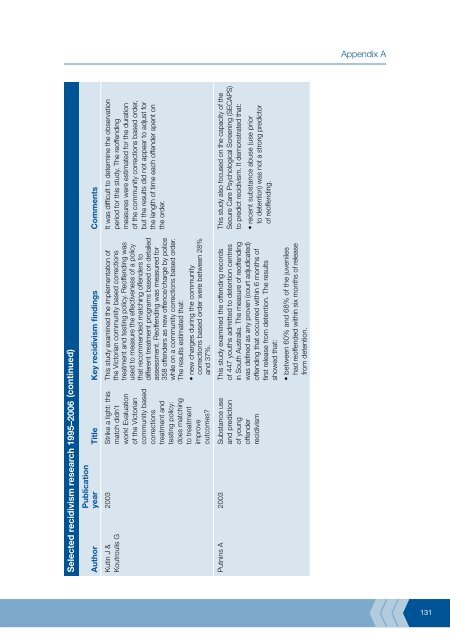Recidivism in Australia : findings and future research - Australian ...
Recidivism in Australia : findings and future research - Australian ...
Recidivism in Australia : findings and future research - Australian ...
You also want an ePaper? Increase the reach of your titles
YUMPU automatically turns print PDFs into web optimized ePapers that Google loves.
(cont<strong>in</strong>ued)<br />
Selected recidivism <strong>research</strong> 1995–2006<br />
Publication<br />
year Title Key recidivism f<strong>in</strong>d<strong>in</strong>gs Comments<br />
Author<br />
It was difficult to determ<strong>in</strong>e the observation<br />
period for this study. The reoffend<strong>in</strong>g<br />
measures were estimated for the duration<br />
of the community corrections based order,<br />
but the results did not appear to adjust for<br />
the length of time each offender spent on<br />
the order.<br />
This study exam<strong>in</strong>ed the implementation of<br />
the Victorian community based corrections<br />
treatment <strong>and</strong> test<strong>in</strong>g policy. Reoffend<strong>in</strong>g was<br />
used to measure the effectiveness of a policy<br />
that recommended match<strong>in</strong>g offenders to<br />
different treatment programs based on detailed<br />
assessment. Reoffend<strong>in</strong>g was measured for<br />
358 offenders as new offence/charge by police<br />
while on a community corrections based order.<br />
The results estimated that:<br />
2003 Strike a light: this<br />
match didn’t<br />
work! Evaluation<br />
of the Victorian<br />
community based<br />
corrections<br />
treatment <strong>and</strong><br />
test<strong>in</strong>g policy:<br />
does match<strong>in</strong>g<br />
to treatment<br />
improve<br />
outcomes?<br />
Kut<strong>in</strong> J &<br />
Koutroulis G<br />
• new charges dur<strong>in</strong>g the community<br />
corrections based order were between 28%<br />
<strong>and</strong> 37%.<br />
This study also focused on the capacity of the<br />
Secure Care Psychological Screen<strong>in</strong>g (SECAPS)<br />
to predict recidivism. It demonstrated that:<br />
• recent substance abuse (use prior<br />
to detention) was not a strong predictor<br />
of reoffend<strong>in</strong>g.<br />
This study exam<strong>in</strong>ed the offend<strong>in</strong>g records<br />
of 447 youths admitted to detention centres<br />
<strong>in</strong> South <strong>Australia</strong>. The measure of reoffend<strong>in</strong>g<br />
was def<strong>in</strong>ed as any proven (court adjudicated)<br />
offend<strong>in</strong>g that occurred with<strong>in</strong> 6 months of<br />
first release from detention. The results<br />
showed that:<br />
Putn<strong>in</strong>s A 2003 Substance use<br />
<strong>and</strong> prediction<br />
of young<br />
offender<br />
recidivism<br />
• between 60% <strong>and</strong> 68% of the juveniles<br />
had reoffended with<strong>in</strong> six months of release<br />
from detention.<br />
Appendix A<br />
131















